Individual and collective action
- Individual and collective action
- 1 What is this element?
- 2 Why is this element important?
- 3 Case studies
- 4 Individual and collective action – what is needed?
- 5 Considerations for getting started
- 6 Navigating common problems
- 7 Check your progress
- 8 Implementation tools
- 9 Linking this element to other components in the toolkit
- 10 More resources
Index
- 1. What is this element?
- 2. Why is this element important?
- 3. Case studies
- 4. Individual and collective action – what is needed?
- 5. Considerations for getting started
- 6. Navigating common problems
- 7. Check your progress
- 8. Implementation tools
- 9. Linking this element to other components in the toolkit
- 10. More resources
In any social movement, targeted actions are taken by individuals, groups, and organizations to achieve change that addresses a shared concern or desired change. In this section, you will learn about the components of individual and collective action and some strategies on how to get started.

What is this element?
“Individual and collective action” describes the intentional and purposeful steps taken by committed change agents, groups and other individuals to achieve shared goals (Bate et al., 2004a).
It occurs through mobilization – the process in which change agents, groups and others commit and act together in a coordinated manner in the pursuit of achieving change (Bate et al., 2004a; Carson-Stevens et al., 2013; Herechuk et al., 2010).
Change agents, groups and others can mobilize to implement best practices related to evidence uptake and sustainability. Their actions taken are strategic to realize a vision or goal, such as to achieve excellence in health outcomes or patient safety.
To take individual or collective action, change agents, groups and others must be committed to a shared concern or desired change and be ready to take action. This requires agency, or the ability to choose to take action. Agency is activated when an individual uses their power – the capacity to take action – combined with their courage – the presence of emotional resources to face the barriers or challenges that are a part of a change process – to achieve change (Hilton and Anderson, 2018).
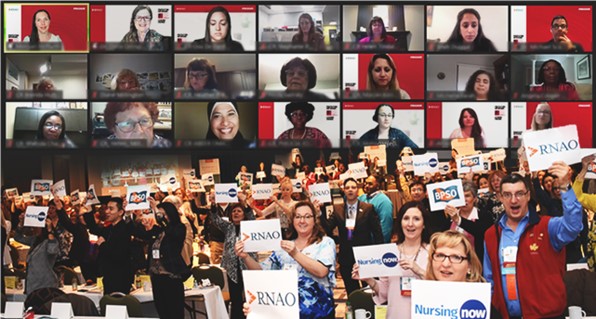
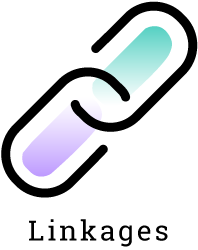
Accelerate Your Success: The Knowledge-to-Action Framework’s “Select, tailor and implement interventions” action cycle phase includes strategies for how to choose implementation interventions to effect change. This includes factors such as the local context, the desired change outcome (e.g., a practice change) and the assessment of barriers and facilitators.
Why is this element important?
As a result of individual and collective action, the shared concern or desired change is addressed – and ideally resolved – according to the goals of the movement (Klaus and Saunders, 2016; Tremblay et al., 2018).
Individual and collective action functions as a tie that bonds people. Sharing experiences builds a feeling of commitment that helps to sustain their active engagement in the change (Embry and Grossman, 2006).
Remember: The goal of any social movement is to mobilize individual and collective action. Without individual and/or collective action, there is no social movement .(Cases-Cortes et al., 2008)
Examples of individual and collective action activities
Individual and collective action activities are specific to a local context and to the goals of the social movement. That means that there is no set list that will apply to all situations.
We share examples of collective action activities here to support understanding and generate ideas:
To support dissemination:
- Hold promotional activities to introduce the social action movement to staff.
- Set up an in-person or virtual information stall with posters and leaflets.
- Send champions and other informal peer leaders to different units to talk to staff.
- Disseminate newsletters detailing activities and updates.
- Engage social media and local media outlets to gain visibility.
To engage partners and others:
- Host fun events to drive staff interest.
- Hold a “go-live” day as an official kick off to your change initiative.
- Meet with community groups.
- Hold public meetings, rallies or protests to raise more general awareness and disrupt norms.
- Design and host education sessions to learn new knowledge and skills.
To engage collective action beyond a local context:
- Participate locally in a change process that is having a global launch. Organize a local launch to motivate participation and change.
SOURCES: Carson-Stevens et al., 2013; Embry and Grossman, 2006; Lippman et al., 2013; Wynn et al., 2011.
Case studies
The Registered Nurses’ Association of Ontario (RNAO) has engaged in grassroots mobilization for more than two decades with thousands of members and other supporters taking individual and collective action. This collective action begins with capacity-building events such as knowledge exchange meetings or other sessions to inform on and debate health policies. RNAO recognizes that evidence alone cannot make change – individual and collective action is required.
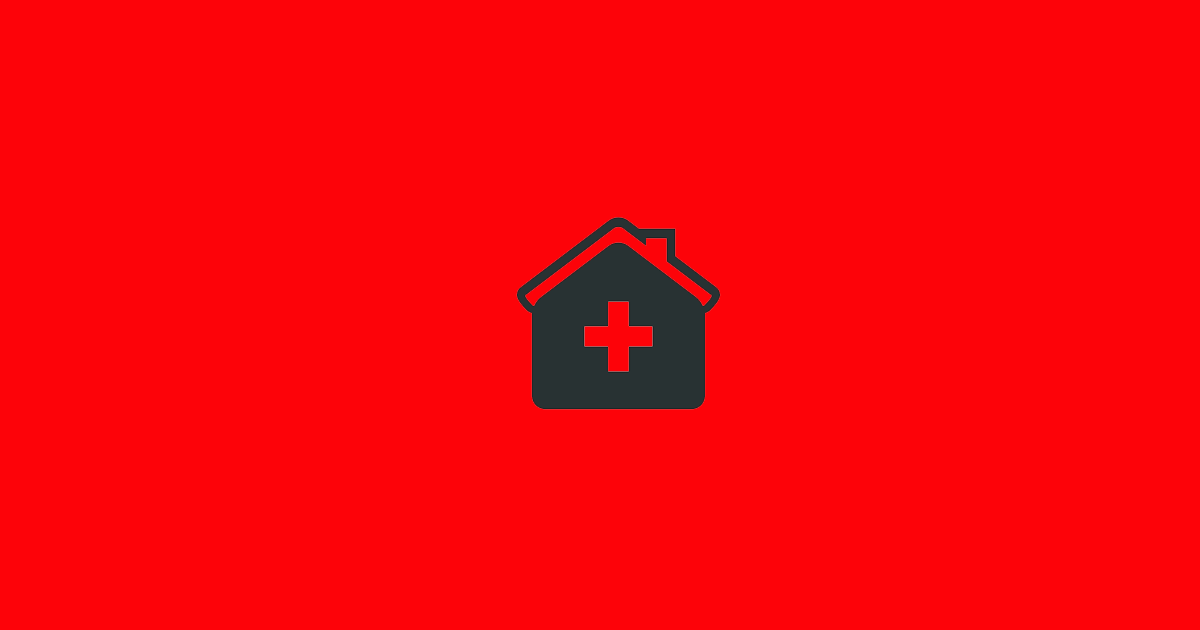
Advocating for supervised injection services to save lives
RNAO supports making harm reduction services available for people who use substances as a means of saving lives, reducing stigma and building healthy communities. As part of this work, RNAO advocates for using evidence to inform policy in the area of supervised injection services.
When the only supervised injection services site in Canada faced threats of closure by the federal government, RNAO mobilized by engaging members’ support, the media and the public. As part of a coalition, RNAO and others advocated for and participated in a hearing before the Supreme Court of Canada.
As a result of the evidence on the benefits of harm reduction and public interventions advocating for the continued access to supervised injection services, the court ruled that the site should remain open. The victory led to the groundwork for additional supervised injection services to open in other provinces across Canada, including Ontario (Grinspun et al., 2018a).
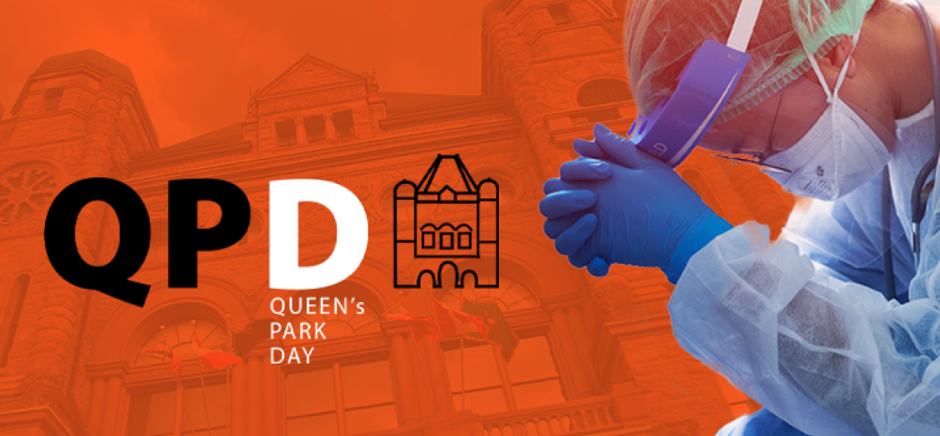
Promoting healthy public policy through mobilized collective actions
Through two annual initiatives – Queen’s Park on the Road and Queen’s Park Day – RNAO members meet with members of provincial parliament (MPPs) from all of the political parties to promote healthy public policy and nursing services. Through direct engagement and advocacy with MPPs, RNAO has mobilized collective action for policy initiatives addressing areas such as poverty reduction, the use of pesticides for cosmetic use, promoting refugee health and protecting the safety and security of residents in long-term care (Grinspun et al., 2018a).

Mobilizing community engagement to sustain a childhood obesity prevention initiative
A community initiative called Sustainable Childhood Obesity Prevention through Community Engagement (SCOPE) provides an example of collective action in the context of public health.
In the SCOPE public health initiative, the community formed a coalition with local partners such as libraries and primary care offices to take collective action for the prevention of childhood obesity. Together, they participated in a range of collective action activities, including: presentations and events promoting healthy eating choices, stakeholder engagement, resource development and policy and practice change (Kennedy et al., 2019a).
Individual and collective action – what is needed?
Five key components are needed to mobilize individual and collective action.
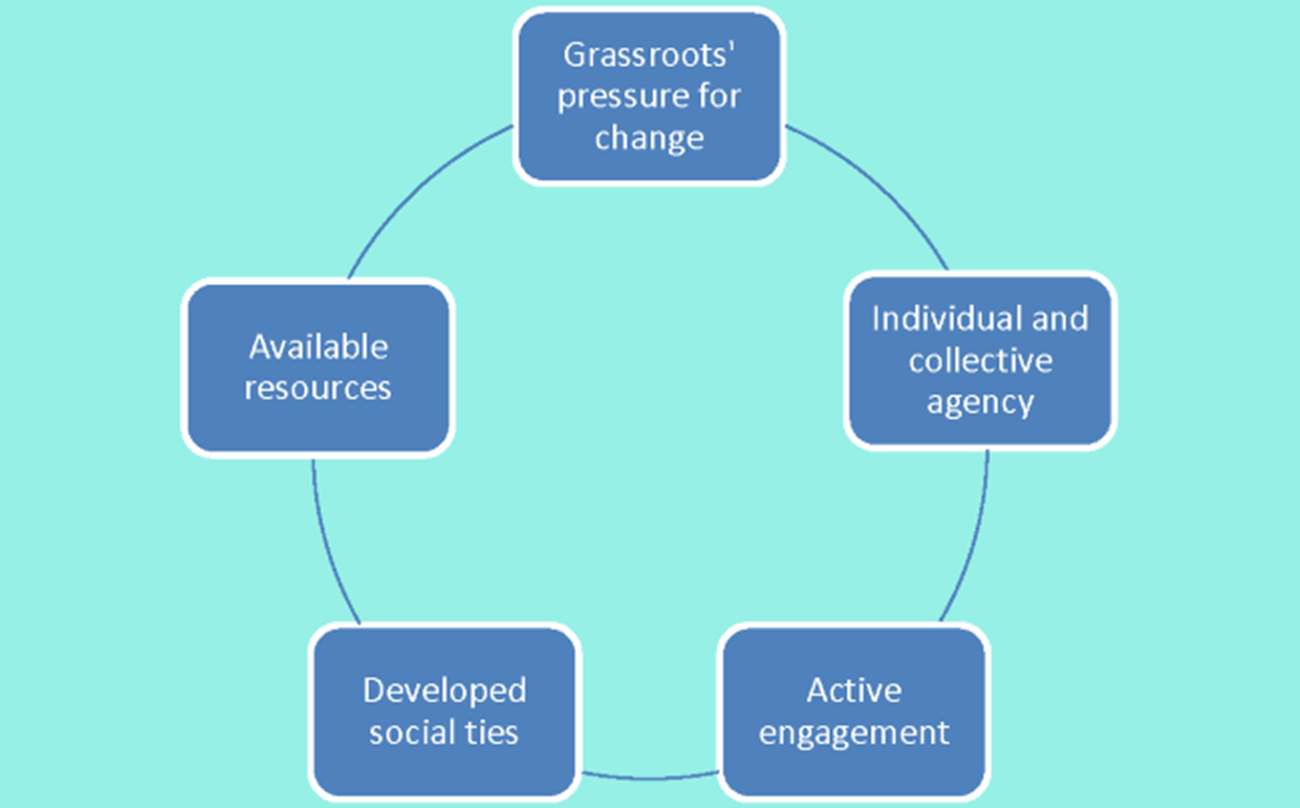
A “bottom-up” or grassroots pressure for change
Individual and collective sense of agency – I/We can make a difference!
Active engagement of change agents and others
Presence of social ties amongst movement members
Resources
“Leaders must know how to mobilize and deploy resources in ways that translate strategy into action. Commitments from movement members – time, skills, and effort – are essential to collective action.” (del Castillo et al., 2016)
Considerations for getting started
To get started with individual and collective action, some strategies are provided below. We categorize the suggestions according to the five key components described above.
A “bottom-up” pressure for change
Individual and collective sense of agency – I/We can make a difference!
Support people to remain actively engaged
Presence of social ties amongst participants
Resources
Navigating common problems
The below lists a few common causes of why collective action activities may slow or stop, and provides suggestions for how you and your change team can respond.
Lack of support
- A lack of support and unwillingness to participate in the social movement leads to a reduction in collective action efforts. Similarly, apathy can hinder or limit collective action efforts. This may be due to uncertainty or a lack of agreement regarding the shared concern or desired change, or in the role and agency of frontline staff as informal leaders and change agents.
- If individuals or groups feel the social movement is a gimmick or not new, or they perceive the social movement as not credible or valuable, they may limit their participation or openly criticize collective action.
- Seek to understand the concerns of individuals about taking action.
- Consider reframing the shared concern or desired change to make it more meaningful to others, and use change agents and other influencers to build support and momentum.
- Reconsider timing if support remains low due to competing priorities.
Limited engagement by change agents. Change agents self-determine their level of engagement. This can be reduced for many reasons. Some examples:
- the social movement may still be at an early stage
- there is a lack of clarity regarding how to get involved
- it is unclear whether all change agents are welcomed and encouraged to get involved and be part of the change
- emerging leadership of change agents is not fostered
- the social movement lacks strategic direction
- the social movement is in appearance only, with roles and leadership of change agents limited to those determined by others, such as senior management teams
- Be inclusive and welcome anyone who is interested in getting involved and being a change agent.
- Develop a list of actions that change agents can take.
Limits to individual and/ or collective agency.
- Individuals may want to take action, but do not know how to advocate for a cause or are fearful of publicly taking action due to perceived or actual risks. This may stem from their personal experiences of lacking power due to disenfranchisement or discrimination.
- Individuals may be resistant to take individual and collective action, because of fear of uncertainty, ridicule, rejection, or possible losses (for example, job loss).
- Remember that personal conviction or intrinsic motivation is more important than formal skills or positional power. Don’t worry if you lack skills or a formal job title.
- Be aware that many social movements have been led by people who are motivated by a strong personal mission.
- Strive to be as transparent as possible regarding any potential risks involved with engaging in individual and collective action.
SOURCES: Bibby et al., 2009; Carson-Stevens et al., 2013; Hilton and Anderson, 2018; Waring and Crompton, 2017; White, 2001; Wynn et al., 2011.
Check your progress
- You have determined the priorities regarding the shared concern or desired change of change agents and key stakeholders. This may include their opinions about what needs to continue or be stopped, or where you need to generate new ideas.
- Change teams and change agents are demonstrating their commitment to the social movement verbally and through their actions.
- Individual and collective action activities are occurring, and the energy of change agents and others are visible and palpable.
- You have gained access to resources to support change, and promote a sense of agency and shared leadership.
- You revise actions through a collaborative process when needed.
- The knowledge of change agents and others about collective action is expanding to support the ongoing social movement.
SOURCES: Bate et al., 2004a; Bibby et al., 20909; Carson-Stevens et al., 2013; Herechuk et al., 2010.
Implementation tools
Download our checklist for some strategies for getting started with individual and collective action.
Download our worksheet on developing an action plan.
Download our worksheet on developing a strategic plan.
Linking this element to other components in the toolkit
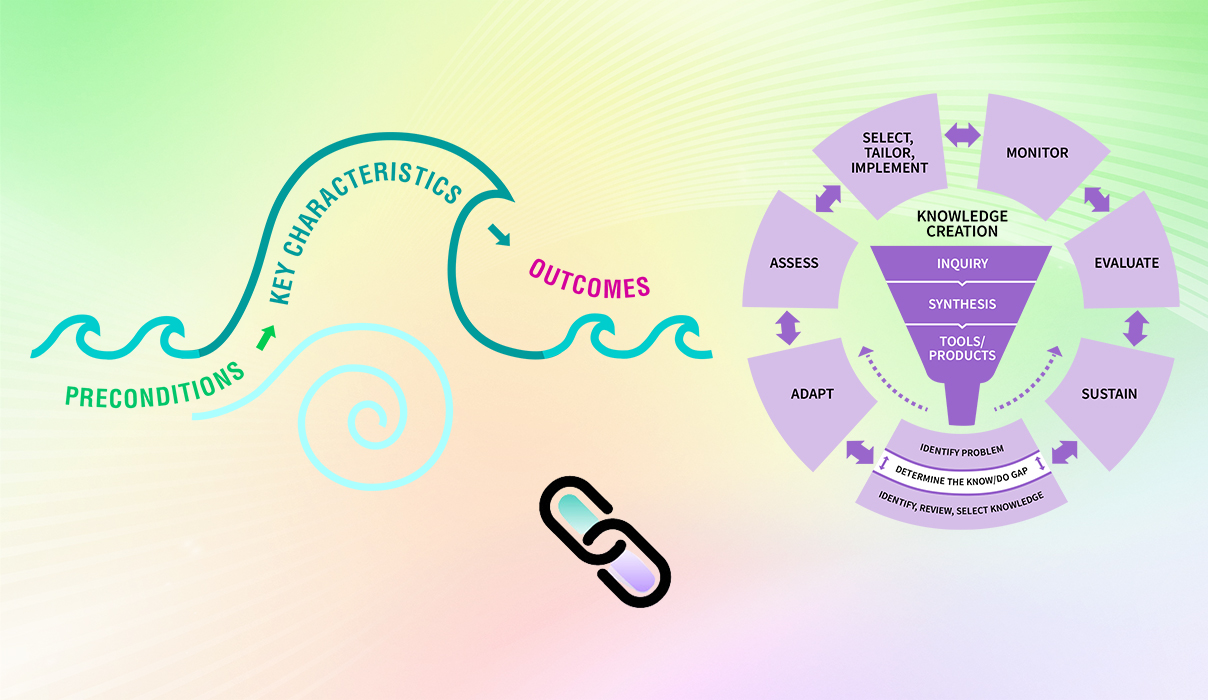
Linking this key characteristic to other elements of the Social Movement Action Framework:
Each of the elements of the Social Movement Action (SMA) Framework is dynamic and interrelated. For example, collective action addresses an urgent need for action and receptivity to change. It applies the strategy of framing to position the issue and the urgent need for change through collective action. Change agents and other supporters take action in part through the engagement of hearts and minds that reflect their intrinsic motivation. As a result of the experiences of collective action, change agents feel a sense of belonging and community which furthers their sense of collective identity. Change agents and change teams demonstrate their emerging leadership through collective action. These individuals and groups may be connected with others through networks and may have core leadership structures to support their collective efforts as the social movement evolves. By mobilizing and using the energy as fuel for collective action, momentum is created.
Linking this key characteristic to the action cycle phases of the Knowledge-to-Action Framework:
You and your change team’s capacity in social movement actions may be enhanced or accelerated by the addition of some of the action cycle phases of the Knowledge-to-Action (KTA) Framework, as the two frameworks are complementary. In addition to the linking example described earlier in this section, there can be many other points of connection between the two frameworks. Here are three examples for you to consider:
- Adapt knowledge to local context: Funding, time and human resources are needed to drive and nourish individual and collective action. The KTA Framework’s phase of assessing the number of resources that can be dedicated to the social movement can help you and your change team understand whether goals and aspirations can be realistically achieved given the availability of resources. Assessing which resources the change agents can access in their settings can help you maximize existing resources, and potentially obtain more resources.
- Select, tailor and implement interventions: Individual and collective action exist to mobilize and achieve shared goals. Incorporating the select, tailor and implement intervention phase of the KTA action cycle can facilitate the coordinated steps change agents take throughout the social movement.
- Monitor knowledge use: It will be important to monitor how change agents are using the knowledge and information in their individual or collective action. For instance, how are change agents (individually and/or collectively) using the knowledge they have about the change when they share information in social media, promote awareness through local seminars, and meet with stakeholders?
For more discussion about the dynamic links between the elements of the SMA Framework and the KTA Framework, see the section "Two complementary frameworks".


